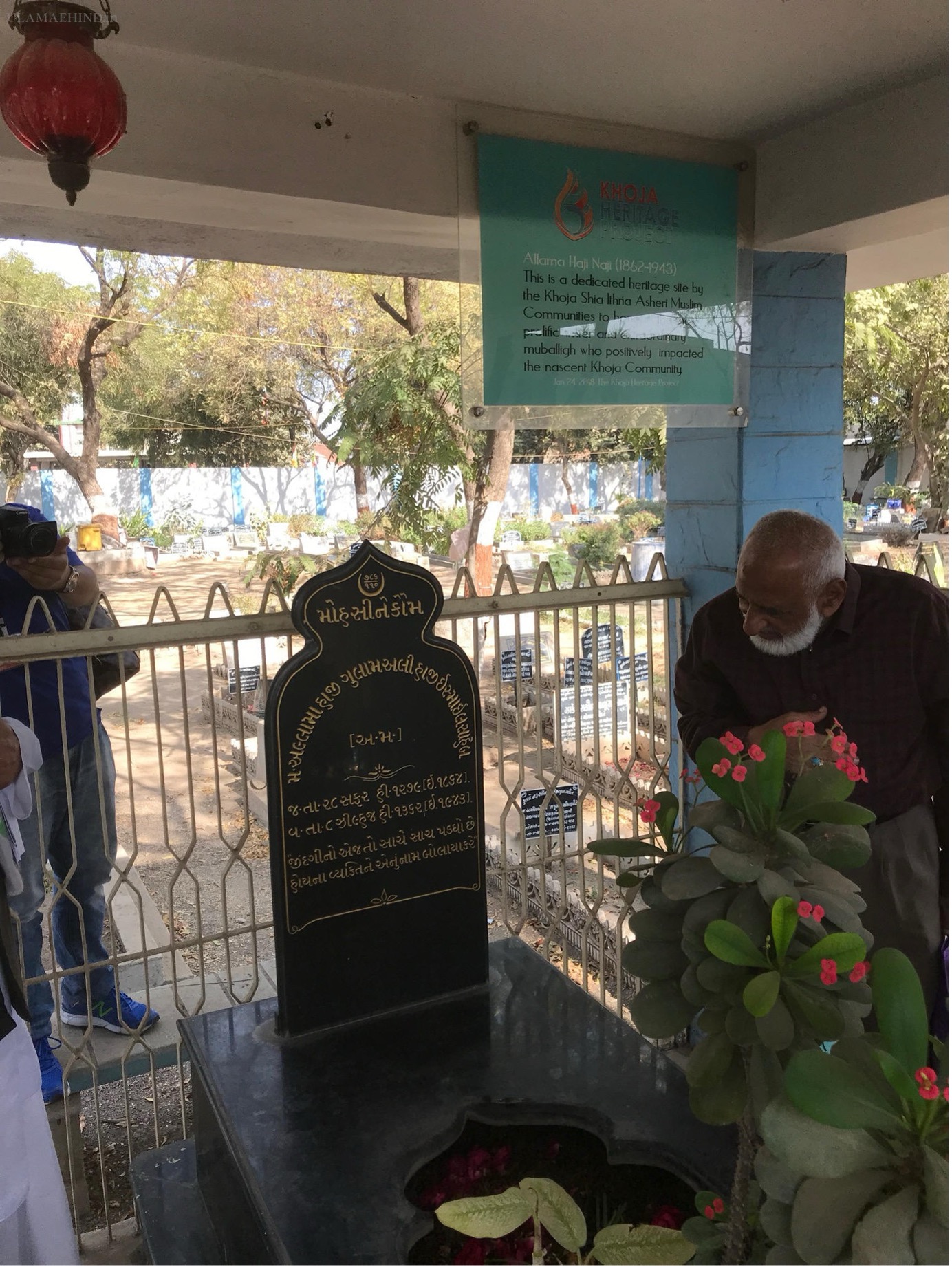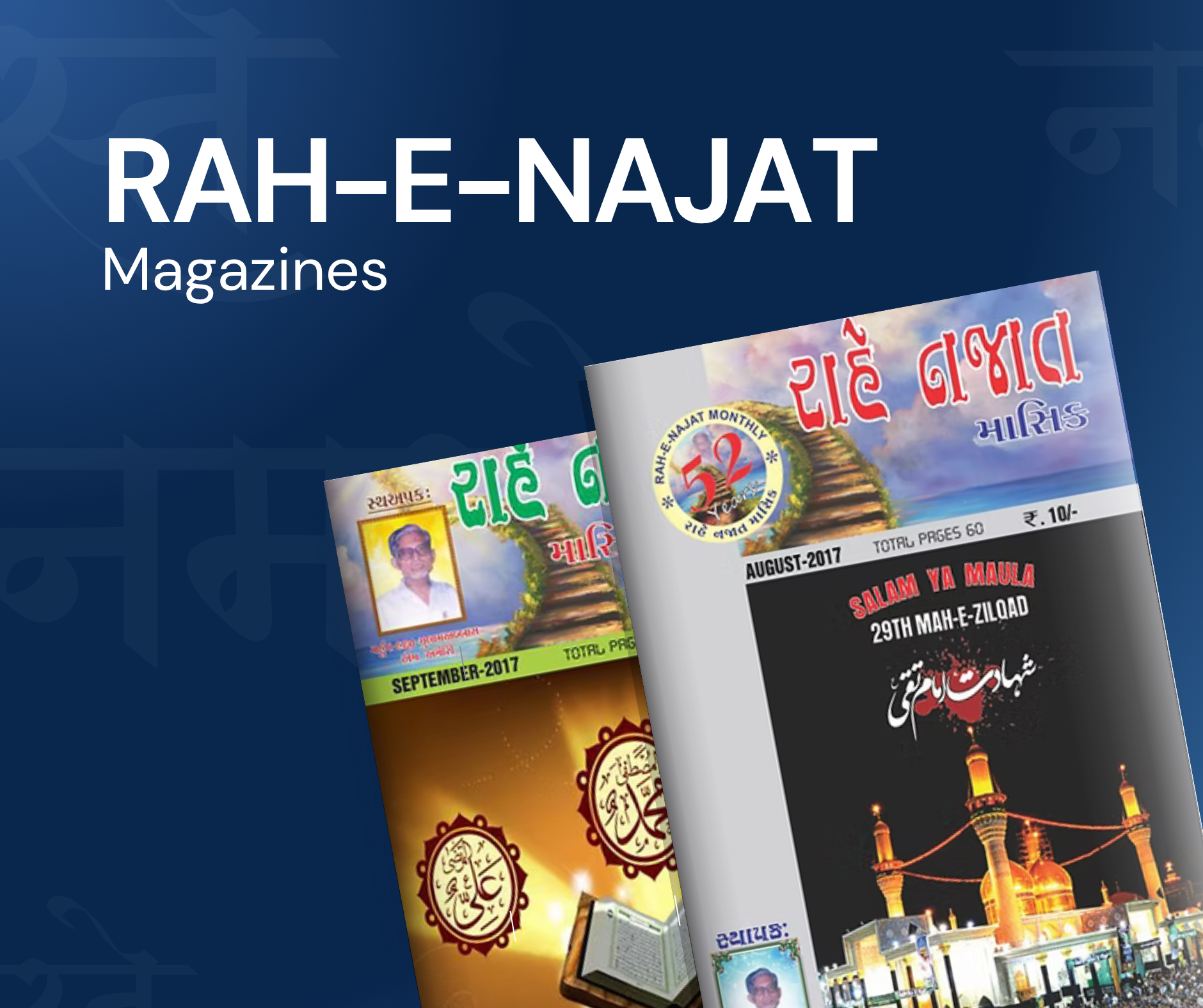- Home
- Article – ʿAllāma Ḥājī Nājī: The Scholar Who Conveyed the Qur’an to Gujarati Hearts
Early Years and Spiritual Awakening
Born in Bombay (Mumbai) in 1864 CE (28 Ṣafar 1297 AH) to a mercantile family originally hailing from Shihor, Gujarat, Ghulām ʿAlī Ḥājī Ismāʿīl – later known affectionately as “Ḥājī Nājī” – was destined to become a beacon of religious revival among the Khoja Shīʿa ithnā ʿasharī Muslims. His father, Ismāʿīl bhāī, was already engaged in trade in Bombay, and the family balanced between commerce and spiritual life, as seen in their early pilgrimage and learning about the Shīʿa ithnā ʿasharī faith.
At around the age of 12, Ḥājī Nājī began attending lectures of Mullā Qādir Ḥusayn, a learned muballigh who had come (at the behest of Ayatollah Mazandarānī) to propagate the Twelver Shīʿa theology among Khojas in Bombay. He quickly absorbed Qurʾānic exegesis, Persian, and Urdu, emerging as one of Mullā Qādir’s brightest students, embodying the saying of Imām al-Kāẓim (ʿa) that true knowledge can only come from a divinely guided scholar.1
A famous anecdote recounts that the teacher once told him, “Today you lift up my shoes; a day will come when people raise you in honour.” Since his early days, Ḥājī Nājī conduct was a living reflection of the Prophet’s teaching that humility elevates a person in rank.2
Soon after a pilgrimage (ziyāra) trip he made with his parents around 1300 AH, young Ḥājī Nājī briefly served as Imām of Jumuʿa in Malegaon, in the Deccan region – an experience that shaped his passion for communal pulpit work. Later, observing the spiritual vacuum in Gujarat’s Khoja communities, he permanently relocated there to begin his mission.
Scholarship, Publishing, and Religious Reform
ʿAllāma Ḥājī Nājī’s intellectual legacy is best measured by his monumental efforts in vernacularizing Shīʿa Islam for Gujarati-speaking Khojas. He established the Khoja Ithnā ʿAsharī Electric Printing Press in Bhāvnagar, pioneering printing and dissemination of religious works in Gujarati. Among his innovations was a system of transliteration of Qurʾānic Arabic into Gujarati script – a radical step in democratising access to the sacred text for those unfamiliar with the Arabic script.
Over his life, he authored and translated over 400 religious texts (according to some estimates) covering Qurʾānic exegesis (tafsīr), prayers, devotional elegies, and legal treatises. Some of his celebrated works include:
Anwār al-Bayān fī Tafsīr al-Qurʾān – a Gujarati tafsīr that blended exegetical, ethical, and spiritual reflections
Miʿrāj al-Saʿāda – Gujarati translation of the classic Persian text
Nūr-i Hidāyat – a practical guide to daily prayers and rituals
Chishma-yi Gham – poetry in praise and lamentation of the Ahl al-Bayt (ʿa)
Majmua-e-Aamal-e-Mukthsar (Majmūʿo) – translation of a collection of duʿāʾs and ziyārāt into Gujarati from Mafātīḥ al-Jinān and collections of, first printed in 1926. Today, this originally Gujarati compilation has been translated to English under the name: “Majmua” and is used in the Indian-Pakistani community.
His magnum opus in public outreach was the monthly magazine Rahe Najāt (“Path of Salvation”), first launched in 1310 AH (circa 1893 CE). Through Rahe Najāt, he addressed theological, ethical, jurisprudential, and spiritual issues pertinent to Khoja communities in India, East Africa, Burma, Oman, and beyond.
In alliance with the broader mission of Mullā Qādir, Ḥājī Nājī’s writings also played a pivotal role in guiding many Khoja families away from Aga Khani (Ismāʿīlī) affiliation toward Ithnā ʿAsharī Shia identity – a process of religious reorientation that transformed the communal landscape. This legacy bears a striking resemblance to our community’s current fervour in authoring much-needed publications like Tafsīr Tadabbur al-Qurʾān, the Madressa Tarbiya Curriculum and others.
A remarkable moment that illustrates ʿAllāma Ḥājī Nājī’s special position within the community and in the eyes of scholars of the ḤawzaʿIlmiyya occurred during a ziyāra to Karbala, when he was entrusted with carrying the answers to 200 fiqhī questions back to Bombay, by Ayatollah Mazandarānī.
Tragically, in 1351 AH (1932 CE) a fire ravaged his printing press and home, destroying many manuscripts and incalculable labour. Yet he accepted the loss with equanimity – reportedly invoking the prophetic tradition: “After every forty days a believer is tested.”
Leadership, Style, and Spiritual Legacy
What made Ḥājī Nājī exceptional was not only his erudition but his humble accessibility. He was often called khādim al-qawm (“servant of the people”) – preaching in Gujarati, speaking in simple yet weighty language, and connecting with ordinary Khojas in their own idiom. His sermons and majālis were not ivory-tower discourses; they addressed everyday moral, spiritual, social, and familial challenges, but also contained substance, leading the guidance of both the laymen and educated members of the community.
In Gujarat, he served as Imām al-Jumuʿa in a number of locales, tirelessly working to uplift religious literacy. His vision of reform embraced women’s access to knowledge, literacy in everyday language, and resistance to religious stagnation.
Upon his death in 1943 CE (6 Dhu al-Ḥijja 1362 AH), he was buried in Bhāvnagar, Gujarat, leaving a void that reverberated across the Khoja world. However, his legacy, like that of true scholars, endured beyond death – for their bodies may perish, but their light remains alive in hearts. 3

After his passing, his son Khādim ʿAlī Kawtharī continued the publication of Rahe Najāt. Over the decades, his books continued to be read in East Africa, North America, Europe, and among Khoja diaspora communities everywhere.
His life truly echoed the hadith-inspired maxim: “Scholars are the inheritors of the Prophets (a).”4 He stands among those who, while not prophets themselves, carried forward the torch of guidance.

Why Ḥājī Nājī Matters Today
In an era when religious identity among Khojas was fragile and contested, Ḥājī Nājī bridged the gulf between scriptural tradition and layman culture. He demonstrated that Islamic knowledge need not remain elite nor esoteric – it can be conveyed in a local tongue and lived among families. His transliteration of the Qurʾān into Gujarati, for instance, anticipated modern efforts of translational theology in non-Arabic communities.
His example also teaches us about service, humility, and sacrifice. The destruction of his life’s work in a fire – yet his peaceful response – mirrors the trials of Ahl al-bayt (a), their companions, and earlier scholars, who strived their best to preserve the Divine guidance, although factors such as oppression and persecution led to the loss of treasures irreplaceable, except but the 12th Imām (aj), as was the case of Muḥammad ibn Abī ʿUmayr (r) (whose sister to bury his manuscripts when he was imprisoned by Hārun, leading to the loss of 94 valuable books) and al-Shaykh al-Ṭūsī (q) (who in the burning of the Shapur library lost many invaluable books and primary sources, including original manuscripts of the companions of the Imāms, (peace be upon them). His leadership was not by power or pomp, but by quiet conviction and consistency.
For the younger generations, Ḥājī Nājī is a reminder that faith without contextualisation can wither. He invites us to ask: How can one root Islamic knowledge in one’s own tongue, culture, and daily life – without dilution? How can one serve one’s community with scholarship, not for ego, but for hudā lil-nās (guidance to the people)?
May ʿAllāma Ḥājī Nājī’s legacy continue to nurture hearts, revive scholarship, and inspire a renewed sense of intellectual piety among Khoja Shīʿa ithnā ʿasharī Muslims and beyond – and may his baraka accompany every seeker of truth.
[1] Imām al-Kāẓim (ʿa): “There is no knowledge except from a scholar who is divinely guided.” (Tuḥaf al-ʿUqūl, p. 387)
[2] The Holy Prophet (saw): “Humble yourselves, and you will be raised in honour.” (Biḥār al-Anwār, v.72, pg. 120).
[3] Imām ʿAlī (a): “O Kumayl, the treasurers of wealth perish though alive, while the scholars remain for as long as time endures; their bodies are gone, but their likenesses dwell in hearts.” (Nahj al-Balāgha, Saying 139).
[4] Al-Kāfī, v.1, pg. 32, narration 2.
